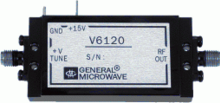Voltage controlled oscillator
In a voltage-controlled oscillator ( English voltage-controlled oscillator , VCO ) is an electrical oscillator , whose frequency by the magnitude of an applied voltage can be changed (control or regulating voltage).
Structure and functionality
The structure of a VCO essentially depends on the operating frequency and the required setting range.
VCOs for high frequencies are mainly implemented by an oscillator circuit , the frequency-determining elements of which can be varied electrically. This can be achieved, for example, by using a capacitance diode in the frequency-determining resonant circuit, the resonance frequency of which can thus be changed by varying the diode bias. VCOs with diode tuning can be tuned over a frequency range of a maximum of about 3: 1, with the quality of the output signal (noise, stability) decreasing as the range of variation increases. If instead of an LC circuit, a quartz used (VCXO, English voltage-controlled oscillator x-tal ), the tuning range is usually only a few thousand of the working frequency.
VCOs for very high frequencies (microwave range) often use a YIG resonator instead of an oscillating circuit as the frequency-determining element , the resonance frequency of which can be changed by varying the surrounding magnetic field (i.e. by changing the coil current of an electromagnet).

In the lower frequency range there is a multitude of circuit arrangements with which variable frequencies can be generated. These are often based on an integrator whose input corresponds to the control voltage and which is reset when a threshold voltage is reached. With such circuit arrangements, relatively large frequency ranges (frequency variation by several powers of ten) can be realized.
application
Electronic music
In electronic music , VCOs are used as assemblies of synthesizers . In modular synthesizers, exponential control has been established as a quasi-standard since the late 1960s, which was developed by Robert Moog for his modular synthesizers. For this purpose, the circuit is designed in such a way that an increase in the input voltage by one volt results in a doubling of the output frequency, i.e. an increase by one octave . Therefore this control is given in volts per octave.
Since the technical implementation with analog electronics poses some difficulties (especially high temperature sensitivity), the Japanese companies KORG and Yamaha decided for inexpensive devices such as B. Korg MS-20 a linear control of Hz / Volt is used. These devices can then not easily be used with devices with exponential control in a musical context.
Usually, VCOs are constructed in such a way that they can generate various waveforms (square, triangle, sawtooth and various others) and allow pulse width modulation of the square wave signal. In addition, there are VCOs which, in addition to the exponential characteristics, also allow linear control. This enables the generation of frequency modulation ( FM synthesis ). Last, let us synchronization as musically important element of a VCO ( English hard sync, sync soft ) above, in which two or more oscillators are synchronized in phase and therefore continue to produce sound spectra.
electronics
The VCO is an element of a PLL circuit ( English phase locked loop ). It is the final control element here and generates a frequency regulated with a feedback loop. Applications are for example stereo decoders , motor controls and PLL decoders.
Furthermore, superheterodyne receivers use voltage-controlled oscillators (resonant circuits with capacitance diodes) to set the receiving frequency (frequency tuning of the mixer oscillator).
VCOs that emit a square wave are used, for example, in sensor circuits or sensors are connected downstream in order to transmit the output signal with two voltage levels without interference and, for example , to be able to process it further in a microcontroller . The information is not in the signal level, but in a continuously variable frequency. This is not a digital signal ; this only arises when the frequency is measured by counting over a fixed period.
A precise voltage-frequency converter IC is for example the LM331. It can also be used as a frequency-voltage converter . A ring oscillator can also be used if accuracy is not required .
